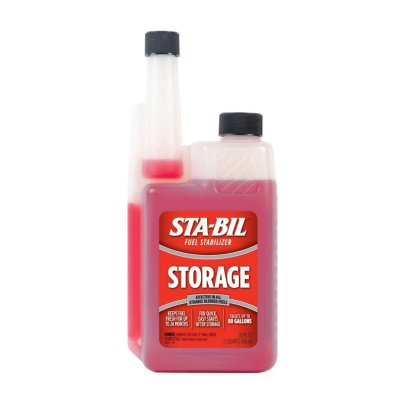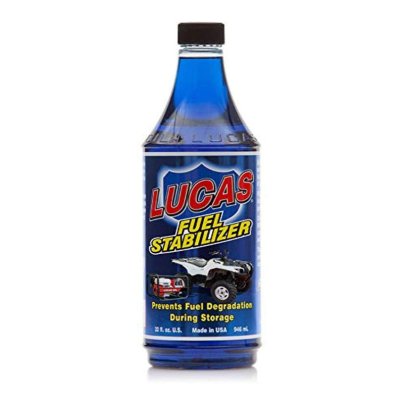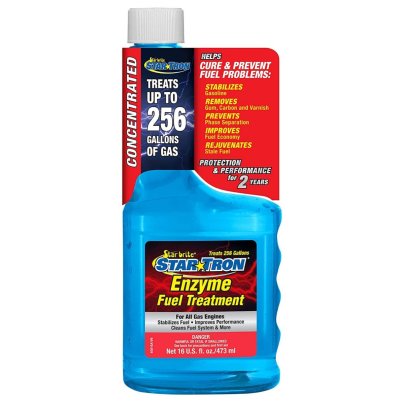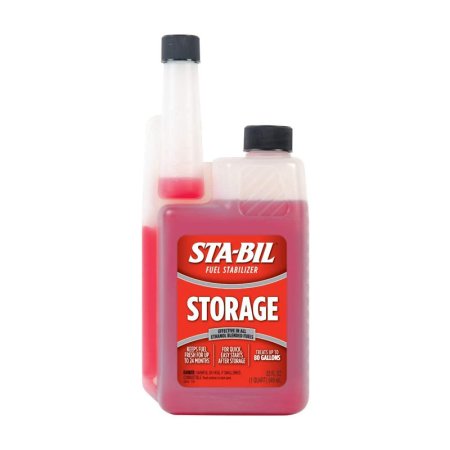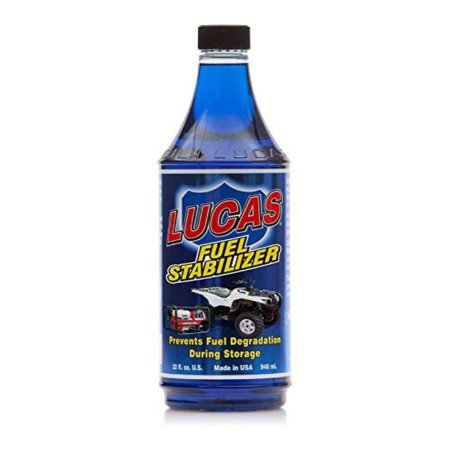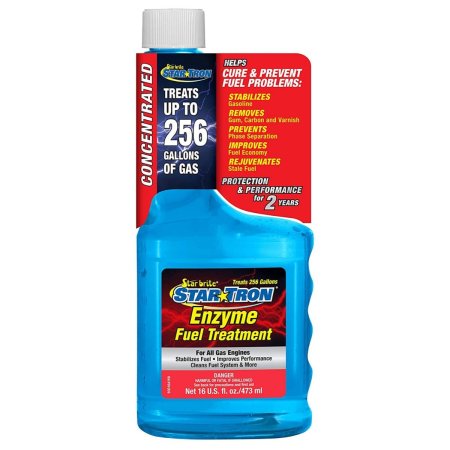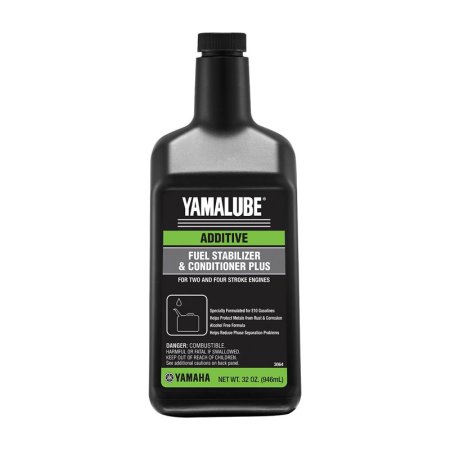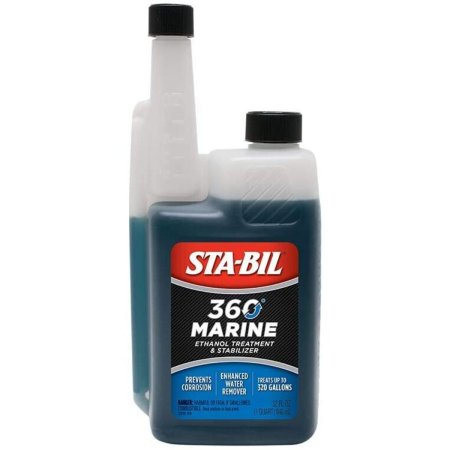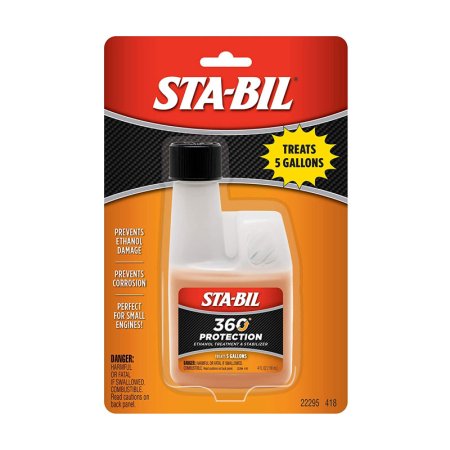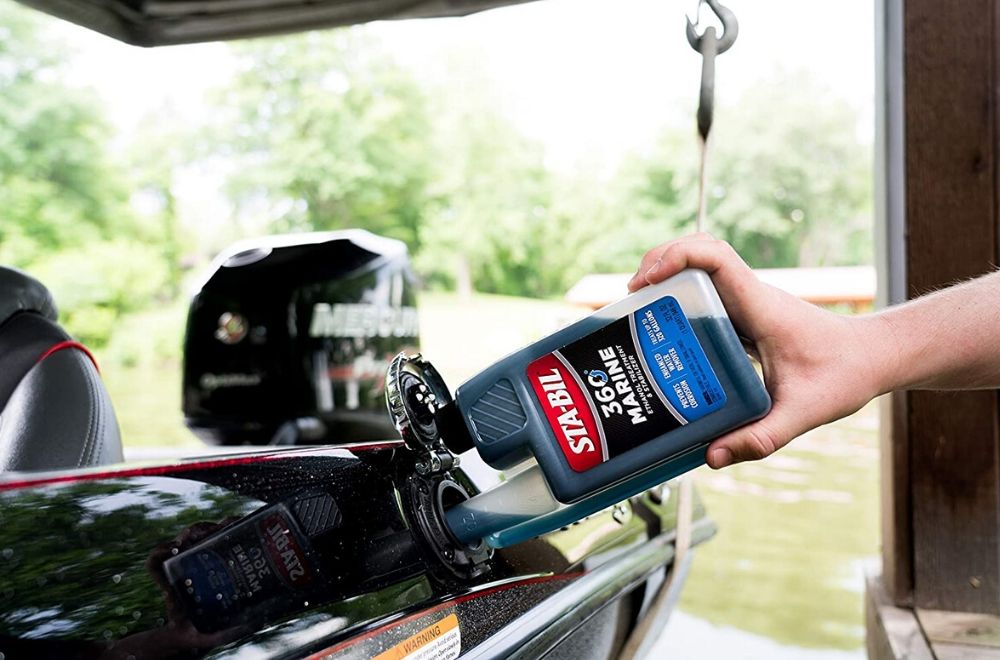
We may earn revenue from the products available on this page and participate in affiliate programs. Learn More ›
When the time comes to store your prized tractor, motorboat, or other fuel-powered gear for the winter, you don’t want to worry about gasoline or diesel “going stale,” gaskets and seals dry-rotting, or gunk building up in fuel lines. Most of these situations can be a nuisance when you bring out your equipment again the following season—an expensive nuisance if it means a trip to a small engine shop for repairs.
Adding a fuel stabilizer to a gasoline storage tank can circumvent these problems. It’ll keep gas fresh and gunk-free and also help retain the fuel’s ignition vapors, necessary for easy starting. Let those vapors dissipate and you’ll be yanking the pull-start in frustration. Pour one of the best fuel stabilizers directly into the tank of your ride-on mower, tractor, or a fuel jug that you store for your snowblower.
Though fuel stabilizer formulas can be a bit complicated, mixing needn’t be a challenge. Most manufacturer directions will call for 1 ounce of stabilizer per a certain number of gallons of gas: this is the stabilizer-to-fuel ratio. A 1:10 ratio, for example, calls for 1 ounce of stabilizer for 10 gallons of gas, while a 2:5 ratio means 2 ounces of stabilizer for every 5 gallons of gas.
Some of the best fuel stabilizers will make it easy to take good care of your gas-powered gear. This guide will offer points to remember before you buy a fuel stabilizer, explore important factors to consider as you shop, and then review some of the top-rated products on the market to keep your outdoor power tools running smoothly.
- BEST OVERALL: STA-BIL (22214) Storage Fuel Stabilizer, 32 fl. oz.
- RUNNER-UP: Lucas Oil 10303 Fuel Stabilizer – 1 Quart
- BEST BANG FOR THE BUCK: Star Tron Enzyme Fuel Treatment Concentrate
- BEST FOR YARD EQUIPMENT: Yamaha ACC-FSTAB-PL-32 Fuel Stabilizer & Conditioner
- BEST FOR SMALL BOAT ENGINE: STA-BIL 360 Marine Ethanol Treatment and Fuel
- BEST FOR DIESEL ENGINES: STA-BIL (22254) Diesel Fuel Stabilizer
- BEST FOR GAS JUGS: STA-BIL 360 Protection Ethanol Treatment and Fuel
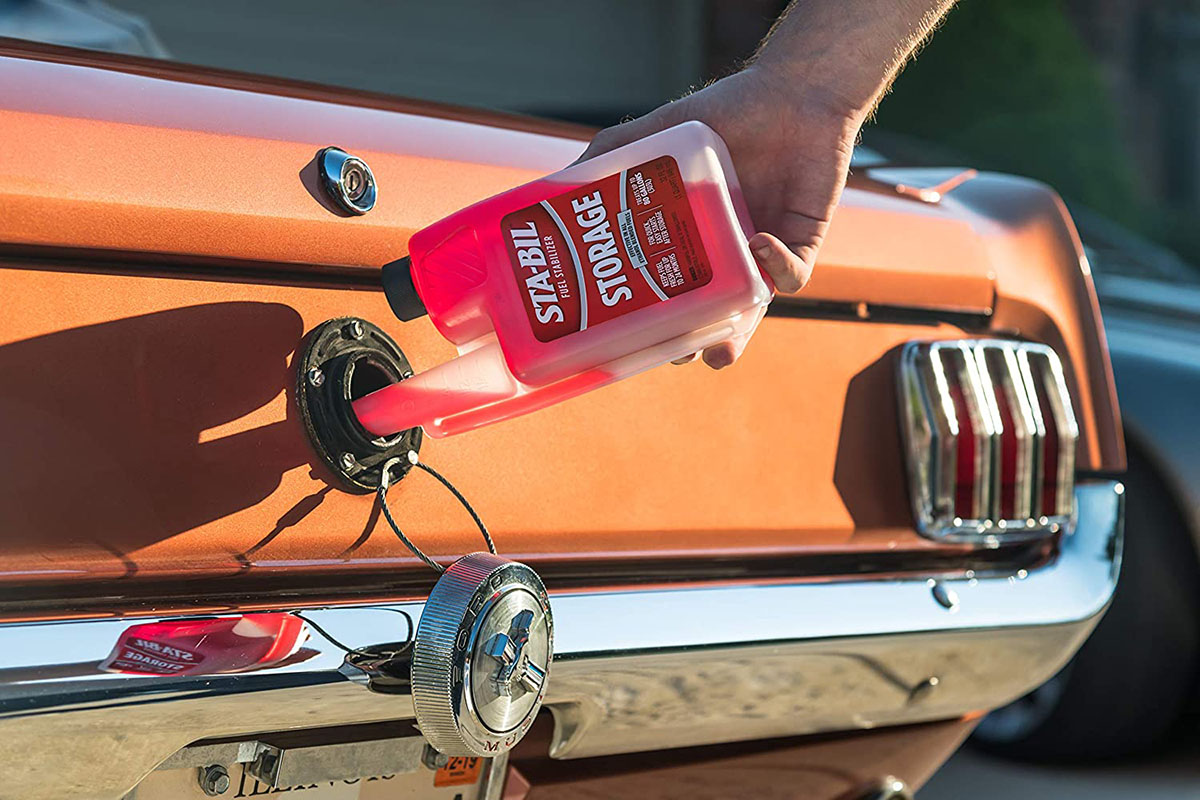
Before You Buy a Fuel Stabilizer
Before you decide to treat your engines to a fuel stabilizer, keep a few points in mind. In certain circumstances, a stabilizer might not be the best choice.
Fuel stabilizers work best in fuel tanks and engines that are in storage for months at a time. If you live in a warmer climate where you’re likely to use your toys and equipment throughout the year, a fuel stabilizer isn’t necessary. In fact, if you’re pouring a fuel stabilizer into a tank of gas and using that gas within a month or two, you’re wasting money.
That’s not to say treating the fuel systems of frequently-run machines is a mistake. The better choice might be a standard fuel system cleaner that will help remove any build-up or gunk that comes with regular use.
What to Consider When Choosing the Best Fuel Stabilizer
Choosing the best fuel stabilizer comes down to a few factors, and it’s worth familiarizing yourself with them. As there are different formulas, types, and rates, it’s important to understand what each product has to offer. Read on to learn some of the most important considerations to keep in mind while shopping for the best fuel stabilizer.
Storage vs. Performance
When it comes to selecting the best fuel stabilizer, there are products for storage and products for performance. While some products bridge the gap between the two types, they typically serve different purposes.
If the treatment is for an engine or gas tank heading into storage for a few months, a fuel stabilizer is necessary. These types of fuel stabilizers help keep the fuel fresh for a longer period of time, holding it over through the colder months when you’re less likely to fire up the engine.
A performance treatment is meant for relatively quick use. Once added to the fuel tank feeding an engine, these types of fuel stabilizers do their best work if used right away. They clean injectors, remove gunk in fuel systems, and generally, albeit temporarily, provide a better quality fuel.
Fuel Type
Different engines use different types of fuel. For example, standard four-stroke gasoline engines in cars, lawnmowers, and generators use fuel directly from a gas station fuel pump. Two-stroke engines, like those found in chainsaws and some four-wheelers and dirt bikes, require users to mix oil into the gasoline. Further, diesel engines use a separate fuel altogether.
Many of the best fuel stabilizers will work for a variety of gasoline types, removing guesswork from the equation. Generally speaking, diesel fuel stabilizers aren’t quite as universal and could possibly damage fuel systems in gasoline engines. For this reason, it’s important to know what type of fuel an engine uses, so you can buy the best fuel stabilizer for that application.
Formula
Just like the different fuel types, there are also a number of fuel stabilizer formulas from which shoppers can choose. These different formulas address certain situations, such as weather or functions, that call for certain characteristics or ingredients.
For example, marine fuel is more likely to take on moisture than other fuels, so a marine-grade formula will do a better job of displacing water. Winters are more likely to cause gelling and gunk, so a winter formula will stabilize fuel by fighting those tendencies. Storage-specific formulas are better for long-term storage in any setting.
Treat Rate
Regardless of which of the best fuel stabilizers you choose, each will have its own treat rate. This rate explains the amount of fuel one bottle or serving of stabilizer can treat.
Each manufacturer is different, but some concentrated formulas use the bottle’s cap as a measurement guide for the stabilizer. Other stabilizers might include measurement marks on the side of the bottle. The directions will indicate how much fuel each of those measurements will treat, often allowing one bottle to treat up to 80 gallons or more of fuel.
If you’d prefer not to deal with ratios and measurements, there are products that use more straightforward treat rates, such as half a bottle of stabilizer for 5 gallons of fuel, and so on.
Longevity
Knowing how long a product will stabilize fuel could be a deciding factor when choosing the best fuel stabilizer. For engines such as those in emergency generators, a tank of fuel can sit unused for quite a long time. Some of the best fuel stabilizers will keep fuel fresh for up to 24 months, making them ideal for generators, equipment at vacation homes, or even some classic cars that might sit in storage for a while.
Keep in mind that if the fuel isn’t already fresh, a stabilizer won’t have the same effect. In those cases, it’s best to run the engine with the older fuel or drain it and put fresh fuel in the tank.
Our Top Picks
Whether it’s for storing a boat or keeping a can of gasoline fresh over the winter, the following list of the best fuel stabilizers includes an option for just about every situation. Be sure to keep the above-mentioned considerations in mind when choosing among these top-rated products.
Best Overall
STA-BIL (22214) Storage Fuel Stabilizer, 32 fl. oz.
For an all-around fuel stabilizer that offers plenty of flexibility, be sure to check out STA-BIL Storage Fuel Stabilizer. This 32-ounce bottle of stabilizer will treat up to 80 gallons of fuel, allowing users to stretch their fuel-saving budget a bit further. And, by keeping fuel fresh for up to 24 months, it’s a logical choice for generators or lawn equipment at vacation homes or cabins. This fuel stabilizer works with different types of gasoline engines, whether it’s two-stroke or four-stroke. Mixing this stabilizer is simple as well; each bottle offers a filler stem to measure the proper amount of stabilizer without fiddling with bottle caps or funnels.
Runner-Up
Lucas Oil 10303 Fuel Stabilizer – 1 Quart
Gearheads and motorsports fans are familiar with Lucas Oil, as the company has a sponsored vehicle in nearly every race. This fuel stabilizer is part of the brand’s lineup. The stabilizer works for different gasoline fuel systems, including two- and four-stroke engines. It prevents fuel degradation and the harmful effects of ethanol on a fuel system, like rust and corrosion. This versatile product also cleans and lubricates fuel pumps, carburetors, and injectors. The 32-ounce bottle of fuel stabilizer requires a relatively high concentration, at 1 ounce to 1 gallon of fuel, which makes it slightly more expensive than some other products.
Best Bang for the Buck
Star Tron Enzyme Fuel Treatment Concentrate
If you aim to stretch a fuel-stabilizing buck, reach for Star Tron’s Enzyme Fuel Treatment Concentrate. This formula is highly concentrated, so one bottle will treat 256 gallons of gas: the breakdown is 1 ounce per 16 gallons. It stabilizes and maintains gasoline performance for up to two years in different engines, including two-stroke engines like chainsaws and some ATVs. This fuel stabilizer is ideal for anyone with lots of toys and equipment, as the 16-ounce bottle really does go far. However, Star Tron recommends an initial treatment of twice the strength. After the initial treatment, reduce it to the standard ratio.
Best for Yard Equipment
Yamaha ACC-FSTAB-PL-32 Fuel Stabilizer & Conditioner
When it comes to yard equipment, keeping two- and four-stroke fuels straight can be enough of a challenge. Trying to find a fuel stabilizer to work with each of those fuels is even more difficult. Instead of storing several fuel stabilizers, this option from Yamaha can handle them all. For both two- and four-stroke engines, it will stabilize the fuel in the gas tank and help prevent build-up and gunk. The stabilizer also works to reduce the effects of corrosion by displacing water. And, with a ratio of 1 ounce to 3 gallons, a single 32-ounce bottle will treat up to 96 gallons of fuel, which is a lot of fuel for the small engines found in yard equipment.
Best for Small Boat Engine
STA-BIL 360 Marine Ethanol Treatment and Fuel
Moisture can destroy a fuel system, so it makes sense that a boat’s fuel system is particularly susceptible to rust and corrosion. STA-BIL’s 360 Marine Ethanol Treatment treats the entire system with a protective coating, minimizing the negative effects of water and ethanol. It also boasts water-removal properties to keep fuel pure. This formula will keep fuel fresh for up to 12 months, making it more likely to achieve better fuel mileage—a real benefit considering how pricey gas is at marinas. One ounce from this 32-ounce bottle is enough to treat 10 gallons of gasoline, and although it’s specially formulated for boats, this product can be used in most gasoline tanks and jugs.
Best for Diesel Engines
STA-BIL (22254) Diesel Fuel Stabilizer
For anyone who rides a classic diesel tractor for yard maintenance, it’s probably a source of pride and joy. And owners of this equipment are also no doubt acutely aware of what cold weather can do to diesel fuel. Adding STA-BIL Diesel Fuel Stabilizer to a diesel fuel tank will help avoid the gel, sludge, and sediment buildups that cause clogged fuel filters and hard starts. This product follows the STA-BIL 1:10 ratio of ounces of stabilizer to gallons of fuel, so this 32-ounce bottle will treat several pieces of equipment, including diesel generators and vehicles. Be aware, however, that this product is strictly for diesel engines; don’t use it in a gasoline fuel system, where it’s bound to cause poor performance or damage.
Best for Gas Jugs
STA-BIL 360 Protection Ethanol Treatment and Fuel
Most folks store gasoline for their power equipment in 2.5- and 5-gallon fuel jugs, and measuring a quarter of an ounce for a 1:10 ratio is a pain. Since no one wants to spend time measuring smelly, fuel-based chemicals, STA-BIL’s 360 Protection Ethanol Treatment comes in a 4-ounce bottle that will treat 5 gallons of gasoline, making it ideal for gas jugs and small tanks. For smaller fuel jugs, simply pour in half of the bottle; larger jugs will take the entire bottle. While this formula helps to reduce the harmful effects of ethanol on a system (such as rust and corrosion), the primary use in a fuel jug is to preserve the quality of the gasoline. This fuel stabilizer helps remove moisture from the gasoline and maintain starting vapors, making it easy to just top off the equipment in the spring and get going.
Tips for Using Fuel Stabilizer
When using a fuel stabilizer, it’s always best to start with a fresh tank of gas. This applies to vehicles and yard equipment as well as fuel tanks. If fuel is already past its prime, a fuel stabilizer won’t make much difference.
To move the fuel stabilizer through the rest of the system, run the engine for a while after adding it. This helps the stabilizer work its way into the system, removing gunk and preventing build-up and moisture in the fuel lines and carburetor or injectors.
It’s very important not to use diesel fuel stabilizers in gasoline fuel systems. Diesel ignites at much higher temperatures than gasoline and so do its appropriate additives. The fuel stabilizer won’t ignite in a gasoline engine, but it could create quite a bit of smoke and also can damage the motor.
- Start your fuel stabilization with a fresh tank of gas.
- Run the engine for a few minutes to circulate the stabilizer throughout the fuel system.
- Use the correct stabilizer for the fuel type.
The Advantages of Owning the Best Fuel Stabilizer
After storing a piece of equipment, car, boat, or another fuel-burning machine, it can be very difficult to start the engine. This is because the quality of the fuel degrades over time. With the best fuel stabilizer in the tank, the gasoline should stay much fresher and provide a quick and easy start.
The best fuel stabilizers can actually save money and hassle. Instead of discarding a tank of old fuel or running low-quality fuel through a system, the best fuel stabilizer helps avoid this situation altogether.
Some people only take their classic cars out once a year to keep up with the state inspection. With old fuel in the tank, there’s a good chance they’ll have a hard time passing the emissions test. The best fuel stabilizers can keep the fuel tank fresh and actually lower emissions, allowing you to:
- Start engines without difficulty.
- Avoid draining and disposing of old fuel.
- Lower your car’s emissions output.
FAQs
If you still have some lingering questions about the best fuel stabilizers, this section is for you. It’s a collection of the most frequently asked questions about fuel stabilizers. Be sure to check for an answer to your question below.
Q: How does fuel stabilizer work?
Oxygen and moisture are the enemies of gasoline or diesel fuel. A fuel stabilizer works by preventing the oxidation and chemical breakdown that occurs inside a fuel tank or fuel system.
Q: Are all fuel stabilizers the same?
No. There are many differences between the fuel type, the engine type, and the specific formula. Be sure to purchase a fuel stabilizer that works for your fuel and engine type.
Q: Is fuel treatment the same as fuel stabilizer?
Many fuel treatments contain fuel stabilizers, but not all of them. Fuel stabilizers help improve the lifespan of the fuel, while fuel treatments clean up the fuel system and improve performance.
Q: Can you use too much fuel stabilizer?
Yes, depending on the product. Always follow the directions on the fuel stabilizer bottle. Otherwise, you could dilute the fuel too much and cause detonation issues in the engine.
Q: How long does fuel stabilizer last in fuel?
While gasoline stays fresh for a few months, some of the best formulas can last up to 24 months.
